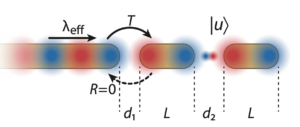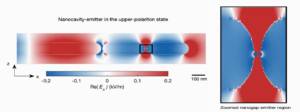Quantum states are incredibly sensitive to their environment, making them perfect for ultrasensitive quantum detection—if they can be maintained long enough. Achieving stable quantum states in coupled light-matter systems could revolutionize materials science, leading to new properties that can be switched and tuned using light.
However, quantum systems in excited states tend to decay rapidly to their ground states, often by emitting a photon. This decay occurs because the quantum system interacts with the surrounding radiation field. While one might think that continuously supplying photons to the quantum system would prevent this decay, the randomness of the decay process itself makes this ineffective. Additionally, constant photon pumping can cause the system to oscillate between ground and excited states, due to the alternating actions of stimulated emission and absorption.
Is it possible, then, to keep an excited state alive for extended periods of time?
In a groundbreaking article published in Nature Communications, researchers from Trinity College Dublin, the University of Würzburg and the IPHT in Jena propose a novel method to ‘immortalize’ the excited state of a strongly coupled light-matter quantum system. By using an innovative nanoplasmonic type of a sophisticated technique called ‘coherent perfect absorption’ that allows to precisely tune losses on the nanoscale, they can supply photons to the quantum system in a precise manner, preventing it from decaying. This technique is akin to the quantum Zeno effect, where continuous observation of the quantum state projects it into the excited state without causing stimulated emission.
Professor Ortwin Hess from the School of Physics and the CRANN Institute and AMBER Centre at Trinity College Dublin explains: “Our study establishes a previously unexplored paradigm for quantum state preparation and coherence preservation in plasmonic cavity quantum electrodynamics, offering compelling prospects for elevating quantum nanophotonic technologies to ambient temperatures. Moreover, implementing our novel quantum state protection in integrated and electrically-operable nanoplasmonic platforms may lead to powerful, on-chip quantum technologies extending from long-lived polariton networks for quantum computing and simulation to quantum optoelectronic devices based on robust, light-induced quantum phases in solid-state systems. It conceivably also opens a path to as-yet unexplored quantum nanoplasmonic memory schemes, where preserving the coherence of plasmon-emitter entangled states could extend quantum information storage times for quantum computing and networking applications at the nanoscale”. Professor Bert Hecht from the University of Wuerzburg adds: “The exquisite sensitivity of our scheme renders it a natural candidate for quantum sensing and the method for preparing persistent quantum states may have applications in developing materials with light-induced switching and tuning of their physio-chemical properties”.
Authors: Yiming Lai, Daniel DA Clarke, Philipp Grimm, Asha Devi, Daniel Wigger, Tobias Helbig, Tobias Hofmann, Ronny Thomale, Jer-Shing Huang, Bert Hecht, and Ortwin Hess.
Room-temperature quantum nanoplasmonic coherent perfect absorption.
Nature Communications 15, 6324 (2024).
DOI: https://doi.org/10.1038/s41467-024-50574-9

Figure: Preparing and ‘immortalizing’ strongly coupled light-matter states via quantum nanoplasmonic coherent perfect absorption. A nanoplasmonic waveguide-driven nanocavity-quantum-emitter system, consisting of a cylindrical, semi-infinite gold nanowire (diameter ) with a hemispherical termination is nearfield-coupled to the nanocavity-quantum-emitterdevice. By fine tuning the nanorod lengths and gap sizes , the individual polariton states (here illustrated for the upper polariton state ) can be selectively initialized via coherent perfect absorption of the plasmonic nanowire mode at the effective wavelength , characterized by zero reflectance and maximal transmittance . In principle, by harnessing the coherent, unidirectional and non-perturbing near-field energy transfer in a regime of exact loss compensation, the strongly coupled state could be immortalized, i.e. protected and preserved in time.
Movie:

Dynamic evolution of the x-electric near-field component of a waveguide-driven nanocavity-emitter system at the critical frequency for qnCPA in the upper polariton state. The global field distribution is displayed on the left-hand side, whilst a magnified view of the nanocavity-emitter region is shown on the right-hand side.
AMBER has a strong emphasis on collaboration. Central to AMBER’s research remit are collaborative projects performed with industry partners, and working with academic, industry and wider stakeholder on international and national research programmes.
Get in touch